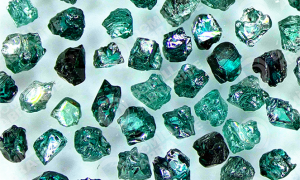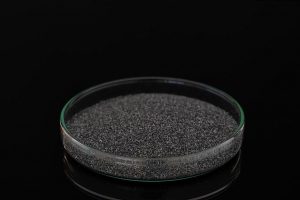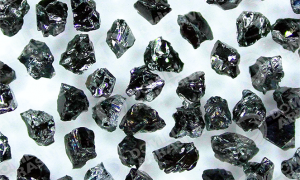Home / News & Blog / What is the Silicon Carbide Powder-Making Process Flow?
Silicon carbide (SiC) is a durable, high-performance material that finds applications across a range of industries—most notably in semiconductors, abrasives, and ceramics. The process of producing silicon carbide powder, which is the foundation of many high-tech applications, involves multiple precise steps to ensure the material meets industry standards.
In this article, we’ll explore the silicon carbide powder-making process flow, from raw material selection to the final milling and purification stages. Whether you’re a manufacturing professional or a curious learner, this comprehensive guide will walk you through the essential phases of silicon carbide powder production.


Silicon carbide powder is a crystalline compound composed of silicon (Si) and carbon (C) atoms. Due to its high thermal conductivity, hardness, and resistance to chemical erosion, silicon carbide is widely used in various applications such as:
-Semiconductor devices: SiC is a key material for high-performance semiconductor components, including diodes and MOSFETs.
-Abrasives: Thanks to its hardness, silicon carbide is used in grinding, cutting, and polishing tools.
-Ceramics: SiC is found in refractory ceramics due to its heat-resistant properties.
-Automotive parts: SiC ceramics are used for making brake pads, clutches, and other components that require excellent wear resistance.
Understanding the detailed process of manufacturing this compound is crucial for industries that rely on its unique properties.


The first and crucial step in the silicon carbide powder production process is selecting high-quality raw materials. The two primary raw materials used are:
-Silicon Source: Typically, silica sand (SiO₂) or silicon metal is used.
-Carbon Source: This is generally petroleum coke or coal tar pitch, although some manufacturers may use graphite for specialized applications.
The quality of these materials significantly impacts the final product. Manufacturers often source high-purity materials to reduce impurities, ensuring the end product meets rigorous industry standards.
Key Points:
– High-purity silica sand or silicon metal
– High-quality petroleum coke or coal tar pitch
– Impact of raw material purity on product quality
The next step in the silicon carbide powder-making process is the carbothermic reduction. This involves heating a mixture of silicon dioxide (SiO₂) and carbon to temperatures above 2000°C in an electric arc furnace. The chemical reaction can be summarized as:
SiO2+3C→SiC+2CO
Key Steps in Carbothermic Reduction:
1. Mixing: The silicon and carbon sources are precisely mixed in a predefined ratio.
2. Furnace Heating: The mixture is placed in a high-temperature furnace, typically an electric arc furnace.
3. Reaction: The high temperature causes the silicon dioxide and carbon to react, forming silicon carbide and releasing carbon monoxide (CO) as a byproduct.
4. Cooling: The mixture is cooled to solidify the silicon carbide, forming large chunks known as “crude SiC.”
Considerations:
– Optimal temperature control is essential to ensure the complete transformation of silicon dioxide into silicon carbide.
– CO emissions are captured and processed to reduce environmental impact.
After the carbothermic reduction, the resulting crude silicon carbide is coarse and needs to be broken down into fine powder. The material undergoes a crushing and grinding process to achieve the desired particle size.
Steps Involved:
1. Primary Crushing: Large chunks of silicon carbide are fed into a crusher, which breaks them down into smaller pieces.
2. Grinding: The smaller pieces are ground using ball mills, roller mills, or attrition mills to produce a fine powder.
3. Particle Size Control: Sieving and classification processes are used to ensure consistent particle size distribution.
Key Considerations:
– Grinding mills must be carefully selected to avoid contamination.
– Accurate particle size is critical for applications that require specific specifications.
The purification stage is crucial, especially for high-purity applications like semiconductors. Impurities such as iron, aluminum, and calcium are removed from the silicon carbide powder through chemical or physical methods.
Purification Methods:
1. Chemical Etching: The powder is treated with chemical agents to dissolve and remove impurities.
2. Hydrofluoric Acid Treatment: For ultra-high purity, a hydrofluoric acid (HF) wash may be employed to eliminate trace contaminants.
3. High-Temperature Annealing: Heating the powder in an inert atmosphere can also help in reducing residual impurities.
Importance:
– Higher purity levels lead to better electrical and thermal properties, making the powder suitable for advanced applications.
Once purified, the silicon carbide powder undergoes final milling and classification to achieve the precise specifications required for its intended use.
Steps:
1. Micronization: High-energy mills are used to reduce particle size to the sub-micron level if necessary.
2. Air Classification: Advanced classifiers separate particles based on size, ensuring uniformity in the final product.
3. Quality Testing: The powder is tested for particle size distribution, purity, and other physical and chemical properties.
Quality Assurance:
-Sophisticated testing methods like X-ray diffraction (XRD) and scanning electron microscopy (SEM) are used to ensure that the silicon carbide powder meets industry standards.
The final product is carefully packaged and labeled to avoid contamination during transport and storage. Quality control checks are conducted at every stage of production to ensure compliance with specifications.
Packaging Methods:
– Vacuum sealing for high-purity powder
– Moisture-proof and anti-static packaging
– Clear labeling with batch numbers for traceability
Key Takeaways:
– Quality control at each stage prevents batch variability.
– Proper packaging safeguards the powder’s integrity during transit.
The silicon carbide powder-making process is a multi-stage, technically complex procedure requiring precision and control at every phase. From selecting the right raw materials to purification and quality assurance, each step is crucial for producing a reliable and consistent product. Whether you’re manufacturing for semiconductors, abrasives, or ceramics, understanding this detailed process flow ensures the best results for end applications.
1. What are the primary uses of silicon carbide powder?
Silicon carbide powder is used in semiconductors, abrasives, ceramics, automotive parts, and advanced engineering applications due to its hardness, thermal conductivity, and resistance to wear and chemicals.
2. Why is purity important in silicon carbide powder?
Purity is critical for advanced applications like semiconductor manufacturing, where even trace impurities can affect electrical properties. High-purity silicon carbide enhances performance in high-temperature and high-power environments.
3. What equipment is needed for silicon carbide production?
Key equipment includes electric arc furnaces, crushers, grinding mills, purification chambers, and advanced testing tools like XRD and SEM for quality control.
4. What are the environmental considerations in silicon carbide production?
The production process generates CO emissions during carbothermic reduction, which must be controlled and captured. Proper waste handling and purification steps are crucial to minimize environmental impact.